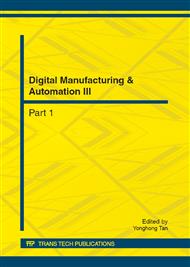p.1244
p.1249
p.1254
p.1258
p.1261
p.1266
p.1269
p.1273
p.1278
Stress Analysis of Tubular Turbine Based on Fluid-Structure Coupling
Abstract:
A brief introduction of fluid-structure coupling and its classification were given, then according to the solving characteristics and application conditions of different coupling methods; sequential coupling method is chosen to calculate the stress distribution of a tide power plant tubular turbine. Stress calculations of the tubular turbine were conducted under the maximum water head, the designed water head, the average water head and the minimum water head working conditions in ANSYS Workbench. The research shows that in all of the four calculated working conditions, the maximum equivalent stress of the runner is located at the connection between the blades and the hub where stress concentration is obvious; the maximum deformation of the runner lies in the outer edge of the blades and the deformation increases from the root to the outer edge; the maximum equivalent stress of the guide vane is located at the root and the maximum deformation lies in the outer edge. The maximum value of maximum equivalent stress of the runner and the guide vane occurs on the maximum water head working condition, whereas it is far less than the material yield limit, which means that static stress will not lead to the cracks of the blade or the guide vane. But it is still necessary to avoid stress concentration appearing periodically in case it causes fatigue failure.
Info:
Periodical:
Pages:
1261-1265
Citation:
Online since:
July 2012
Authors:
Keywords:
Price:
Сopyright:
© 2012 Trans Tech Publications Ltd. All Rights Reserved
Share:
Citation:


